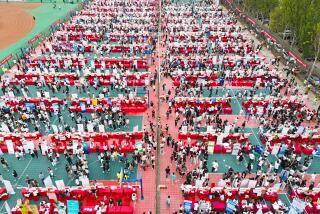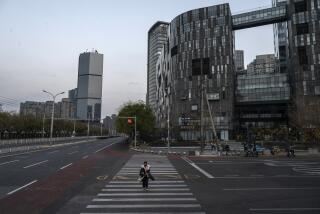Disparity of Change
- Share via
HARBIN, China — As a frigid evening approached in China’s far Northeast, black Audi and Honda sedans bearing government license numbers began to pull up to the high-end restaurants that line Hongxiang Road.
It was another night of wining and dining public officials on what locals call Fubai Jie: Corruption Street.
At Rich & Powerful People Restaurant, a plate of braised abalone was selling for $312, more than two months’ wages for the average worker here. And on a curbside nearby, Zheng Wei, laid off from a state-owned boiler factory 10 years ago, shielded her face from the minus-10-degree air as she peddled crackers, pumpkin seeds and chocolate bars.
“I’m too old to find a new job,” she said, hoping to take home the usual $1 to $2 for three hours of work. “There are many others in the same boat.”
The contrasting picture on Corruption Street illustrates the challenges Beijing faces as it pushes to revitalize the once-proud industrial belt, crack down on bribery and fraud in government and regain the trust of people living in a region with the highest unemployment rate in China.
The three provinces that make up the industrial Northeast -- Liaoning, Jilin and Heilongjiang -- were the first to develop under Mao Tse-tung’s planned economy in the 1950s. But they’ve lagged behind others that were quicker to seize on the market reforms of the last 25 years.
In Harbin, the capital of Heilongjiang, street corners are teeming with laid-off factory workers like Zheng. Although the city of 9 million has had some success of late in revving up its economy, it’s saddled with many state-owned companies that are laden with heavy debts, poor management and bloated workforces with surging pension obligations.
“In the Northeast, the big problem is that we don’t have a lot of private economy in manufacturing and high-end service businesses such as finance and accounting,” said Song Donglin, deputy director of the economics school at Jilin University in Changchun, a center of China’s auto manufacturing.
Lack of access to financial services discourages outside investment, he added, and makes it difficult for laid-off workers to find jobs or start businesses.
“If the Northeast cannot develop,” he said, “it will impose very negative influences to the sustainable development of China’s economy.”
Right now, economic power is concentrated along the coast: Guangdong province in the South, the Shanghai area and Beijing-Tianjin-Dalian corridor to the north. The rural West and smokestack Northeast have trailed badly, stirring unrest among farmers and factory workers.
Four years ago, the central government launched a “Go West” campaign that helped stimulate foreign investments there. About a year ago, a similar initiative was undertaken for the Northeast. Agencies cut farm taxes and provided incentives to lure investors to the region.
In the first half of 2004, officials said, foreign capital inflows to the three Northeast provinces surged 72% to $3.4 billion. That included Anheuser-Busch Co.’s $139-million purchase of state-owned Harbin Brewery Group. Still, the region’s share of China’s total overseas investments is small compared with its population, and it has yet to trickle down to many ordinary people.
The Northeast’s official jobless rate for registered workers isn’t much different from the nationwide figure of about 4%. But researchers say urban unemployment in Heilongjiang, home to declining oil fields, is actually in the double digits and the highest in the country.
Zhang Shixing remembers when the Northeast was a paragon of China’s economic might. As a boy in Harbin in the ‘60s, Zhang tagged along with his mom to Qiulin shopping center, an elegant domed-roof edifice built in 1900 by Russians and taken over by China in 1953. The store was the draw of the entire region, chockfull of foods, clothes and the big three items of that day: radios, bicycles and sewing machines.
“A trip there was like celebrating New Year’s festival,” Zhang said, recalling how he came away with fruit candy and Russian black bread.
Over the last decade, Qiulin has fallen into disrepair. Its gray facade started to peel away. With more than 3,500 employees and 600 pensioners on its payrolls, the department store lost nearly $19 million last year. Its problems seemed to be emblematic of all that was wrong with an economy still operating under a cradle-to-grave mentality known as the iron rice bowl.
This year, Harbin’s government sold its Qiulin shares to a developer from Wenzhou, an entrepreneurial hot spot on China’s southern coast. Zhang, who chairs Harbin’s Technology Service Committee, and others say the arrival of investors from Wenzhou and Hong Kong signals that private enterprise is starting to take hold in the city.
It has a long way to go. Nationwide, non-government companies, including foreign ventures, are driving two-thirds of China’s growth. But in Harbin, the state-owned economy is generating about 80% of the city’s revenue and taxes, said Xu Zemin, an economic specialist at Heilongjiang Provincial Academy of Social Sciences.
Among the most important is a group of three 50-year-old companies called the Big Three Powers, which produce boilers, turbines and electric machinery. Together, they have more than 70,000 workers on the payroll, although about 21,000 of those have been laid off, Xu said.
In all, several hundred thousand people live in the so-called Power Zone, a virtual city in itself consisting of the plants, company-owned housing, schools and hospitals. Every year, the factories spend more than $3.5 million to support these facilities.
At the moment, the Big Three Powers are staying busy, supplying equipment for projects like the Three Gorges Dam. But these power equipment plants are capital-intensive and their profit margins low. And it’s far from clear how long these plants can keep supporting so many workers and their families.
By most estimates, Harbin’s unemployed labor pool exceeds 500,000 adults.
On a recent Saturday morning, dozens were gathered at an informal labor market in the city’s south side. A 48-year-old man, his nose running profusely, said the blanket factory from which he was laid off had been paying him about $12 a month, not nearly enough to buy coal to heat the flat-roof house left to him by his parents.
Others have fared better, said the man, who offered only his family name, Lu. By giving red envelopes with cash to government officials, he said, some of the unemployed are collecting di bao, or minimum unemployment benefits, of about $25 to $35 a month.
“I have no money to bribe with,” Lu said.
Public officials say they’ve tried to eradicate such unsavory practices but acknowledge that it’s not easy given that government workers themselves are paid relatively little. In Heilongjiang province, the average pay of employees at all state-owned units was $1,334 last year, the second-lowest among 31 major areas in the country, according to the National Bureau of Statistics. The countrywide average was $1,763 in 2003.
This summer, Harbin opened a one-stop government services center in the city’s business district. Staffed by 135 employees who work in open view of the public, the center has 104 service windows representing 45 government agencies, including departments issuing various business licenses. Just inside the lobby, several large gold characters are posted on the wall: Gao Xiao Lian Jie -- Efficient, Honest.
“They’re much more responsive,” said Liu Zhen, 43, who recently launched his own fertilizer and soil additives company. “Previously the government didn’t care about helping private businesses.”
Asked whether he or his staff gave a red envelope to any official, Liu offered no direct answer.
“Since the crackdown on corruption, officials are more afraid,” he said. “They’re more subtle about how they get yi si,” or tokens of appreciation.
There’s nothing subtle about Corruption Street.
The restaurants are as garish in appearance as suggested by some of their names, including Rich Capital and New Bright Moon. Some facades are styled in Roman motif, with gold columns; others have onion domes that imitate those on top of the renowned Russian-built churches in the city. At night, the restaurants light up in neon, with parking attendants dressed in long coats and fur hats standing at attention like palace guards.
Not all the restaurants are expensive. But one former government veteran said he was treated to drinks and a meal exceeding $3,500 by a state-owned enterprise seeking a loan.
“That wasn’t so much,” he said, noting that one company currying favor from officials threw a banquet to the tune of $31,000.
Such extravagant displays have elicited scorn and ridicule from ordinary citizens, so much so that public officials are said to park their cars far away from the main drag and walk to the establishments. Some take taxis, which do brisk business there at nights. Others will drive in, and restaurant workers will occasionally cover the license plates, area merchants say.
“I have been running this store for two years,” said Wang Tieliang, 38, a laid-off worker who operates a food market nearby. If there has been a crackdown on corruption, he said he hadn’t seen it. “The situation remains the same as before.”
More to Read
Sign up for Essential California
The most important California stories and recommendations in your inbox every morning.
You may occasionally receive promotional content from the Los Angeles Times.











